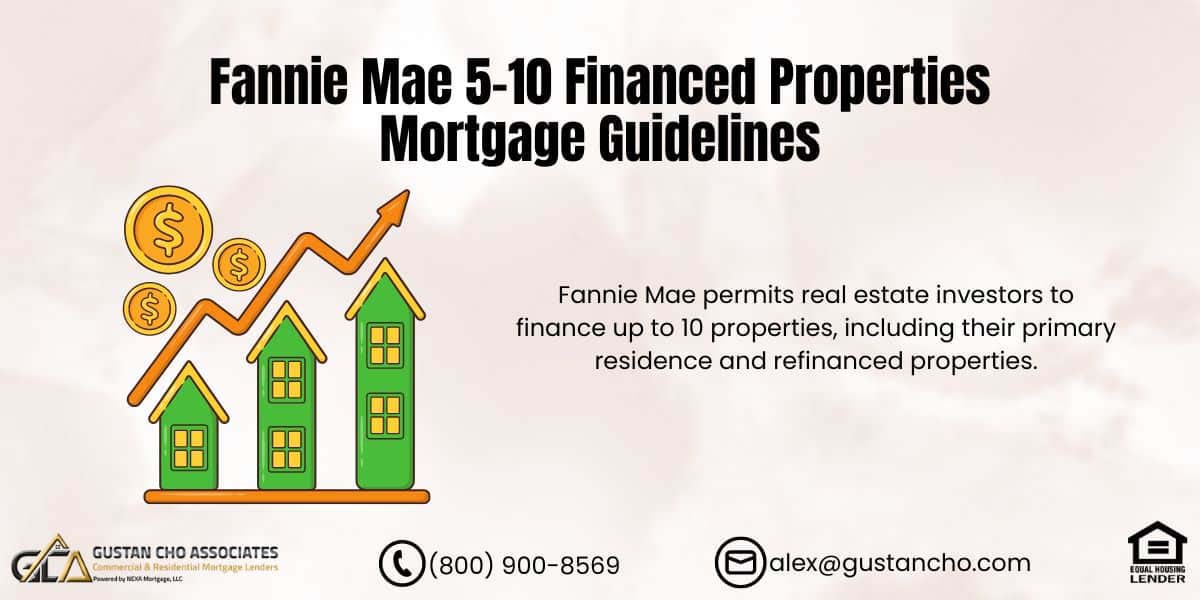This blog post focuses on Fannie Mae 5-10 Financed Properties, which is particularly beneficial for real estate investors. The 2008 Real Estate and Mortgage meltdown led to significant changes within the mortgage industry. One positive development is the return of non-QM loans. These allow homebuyers to secure financing through non-QM stated income and no-doc mortgage loans.
Fannie Mae has introduced updated lending guidelines for 5-10 Financed Properties. While the conventional lending guidelines still apply to investors with up to four financed properties, those holding more than four must adhere to the specific guidelines for 5-10 financed properties.
What is the Maximum Number of Financed Properties for Fannie Mae?
Following the collapse of the real estate and credit markets, Fannie Mae initially capped financed properties at four, which included the homeowner’s principal residence. Subsequently, Fannie Mae revised this policy, allowing homeowners to finance up to 10 properties.
However, not all lenders offer Fannie Mae 5-10 Financed Properties loans. This mortgage market segment is considered a niche, with only a select group of lenders actively promoting these specialized loan programs.
Financing 5 or More Properties at The Same Time
In 2009, Fannie Mae raised the limit on the number of properties a homeowner and real estate investor can finance from 4 to up to 10 units. This change was implemented to boost the United States housing market, enabling investors to buy foreclosures, REOs, short sales, vacant properties, and land, thereby stimulating economic activity in the sector.
Previously, real estate investors were restricted to a maximum of four financed properties following the downturn in the real estate market. However, with the introduction of the Fannie Mae 5-10 Financed Properties program, these investors can now broaden their portfolios and secure financing for additional investment properties.
Own 5 to 10 Properties? You Can Still Get Financing
Fannie Mae allows qualified investors to finance up to 10 properties—don’t let outdated limits hold you back. Check Your Eligibility for the 5-10 Property Loan Program Today!
Underwriting Fannie Mae 5-10 Financed Properties Mortgages
Numerous banks and credit unions tend to refrain from engaging with Fannie Mae 5-10 Financed Properties because the processing and underwriting of these mortgage loans are notably intricate and time-intensive.
In contrast, standard loans such as those for owner-occupied homes, second homes, and investment properties, typically known as simpler mortgage types, are processed more swiftly and straightforwardly, including handling personal and business tax returns.
Verification of Mortgage During Mortgage Process
For Fannie Mae 5-10 Financed Properties, it’s essential to conduct thorough mortgage verification for each property the real estate investor owns. This includes validating all property tax information and ensuring payment compliance for each property. Additionally, all lease agreements across the properties must be verified.
Moreover, the credit and financial profiles of the mortgage loan applicant, including those of any partners and the properties themselves, must also be comprehensively assessed to ensure eligibility and financial stability under the Fannie Mae 5-10 Financed Properties program.
Financing an Investment Home Versus an Owner-Occupant House
Securing approval for a mortgage can be time-consuming and costly. Banks, credit unions, and most other lenders consider financing investment properties through programs like Fannie Mae 5-10 Financed Properties to be high-risk. Consequently, they take extra precautions to ensure that the application is error-free.
The mortgage application, particularly for Fannie Mae 5-10 Financed Properties, undergoes rigorous and meticulous scrutiny during underwriting.
Income Docs Required To Start Mortgage Process
Traditional mortgage loans require two years of W-2s, two years of tax returns, and recent paycheck stubs.
Real estate investors with four or more financed properties, lenders require and underwrite every property schedule on the following: Real Estate Owned Schedules.
What are Fannie Mae guidelines for Financed Properties?
There are two mortgage lending guidelines for 5-10 Financed Properties. Have Fannie Mae’s minimum guidelines, and you have the individual mortgage lenders’ overlays. We will discuss Fannie Mae’s minimum lending guidelines on 5-10 Financed Properties.
Fannie Mae’s guidelines for financed properties, especially for borrowers who own multiple properties, include a variety of requirements and stipulations designed to manage risk. Here are some of the key guidelines for investors looking to finance multiple properties through Fannie Mae:
- Number of Properties:
- Fannie Mae allows a borrower to have up to 10 financed properties, including the borrower’s primary residence and any refinanced mortgages.
- Credit Score Requirements:
- Borrowers generally need a higher credit score to finance more than four properties. The minimum credit score requirement is often 720 or higher.
- Reserve Requirements:
- For properties numbered 5 through 10, borrowers must typically have reserves equal to 6 months of the new mortgage payment (including principal, interest, taxes, insurance, and any association dues) for each property financed. This is in addition to reserve requirements for the borrower’s primary residence and other properties.
- Down Payment:
- The down payment requirements are usually higher when financing multiple properties. For single-family investment properties, a down payment of at least 20% is generally required, and this percentage can increase depending on the number of properties owned and the borrower’s specific circumstances.
- Loan-to-Value (LTV) Ratios:
- More conservative LTV ratios are applied for borrowers with multiple financed properties. Lower LTV limits help mitigate the additional risk of lending to investors with several mortgages.
- Underwriting:
- The underwriting process for borrowers with multiple financed properties is more stringent. Lenders might ask for more paperwork to confirm that the borrower can handle extra debt. This documentation could include evidence of rental income from other properties.
- Documentation:
- Borrowers must provide extensive documentation when financing multiple properties. This includes tax returns, lease agreements for rental properties, and a detailed list of all owned properties and their associated mortgages and expenses.
These guidelines are in place to ensure that investors are financially stable and capable of managing the debt associated with multiple financed properties. Borrowers should consult with lenders or financial advisors to understand fully how these requirements might apply to their situation.
Investor with 5+ Homes? Fannie Mae Has You Covered
Don’t get turned away just because you own multiple properties. Apply Now and Grow Your Real Estate Portfolio!
Fannie Mae 5-10 Financed Properties Down Payment Requirements
The minimum down payment is 25% on any properties between 5 to 10 financed properties that are one unit. The minimum down payment required for 2 to 4-unit properties is a 30% down payment.
The borrower applying for Fannie Mae 5-10 Financed Properties must have a minimum credit score of 720. Borrowers cannot have any mortgage late payment history in the past 12 months. Many lenders may extend this requirement as part of their overlays. Some lenders do not want to see any late mortgage payments, period.
Fannie Mae 5-10 Financed Properties Credit Guidelines of Borrowers
5-10 properties borrowers cannot have had any foreclosures, deeds in lieu of foreclosures, short sales, or bankruptcies in the past seven years. Two years of tax returns and rental income are listed on all schedules for the past two years.
Six months of reserves which consist of principal, interest, taxes, and insurance for every property, including the primary home, is required for all financed properties.
What is the Minimum Loan Amount for Fannie Mae?
Fannie Mae does not set a specific minimum loan amount for most conventional mortgages it purchases. However, lenders may set their minimums based on their policies or the practicality of servicing smaller loan amounts. These minimums vary by lender and may depend on property type, location, and the borrower’s creditworthiness.
For smaller loans, Fannie Mae has a specific program called the “Small Loan Program,” which is designed for multifamily mortgage loans. This program specifically targets loans under $6 million (or under $3 million in some markets), catering to smaller multifamily properties.
If you’re considering a loan that might be lower than what typical mortgage lenders prefer, it’s a good idea to discuss the possibilities with potential lenders to determine their specific minimums and requirements.
FAQ About Fannie Mae 5-10 Financed Properties Mortgage Guidelines
- 1. What is the maximum number of financed properties Fannie Mae allows? Fannie Mae permits real estate investors to finance up to 10 properties, including their primary residence and refinanced properties.
- 2. What are the key lending guidelines for properties financed through Fannie Mae? Standard investment lending guidelines apply to up to 4 financed properties. For properties 5 through 10, borrowers must meet more stringent requirements, including higher credit scores, larger down payments, and sufficient reserve funds.
- 3. What credit score is required for financing more than four properties? A minimum credit score 720 is typically required to finance between 5 and 10 properties.
- 4. What are the reserve requirements for financing multiple properties? Borrowers need reserves equal to 6 months of the mortgage payment (including taxes, insurance, and dues) for each financed property numbered 5 through 10.
- 5. How much is the down payment for Fannie Mae’s 5-10 financed properties? The minimum down payment for single-family investment properties is 25% for properties 5 through 10 if they are one-unit. For two- to four-unit properties, a 30% down payment is required.
- 6. Are there specific underwriting processes for Fannie Mae’s 5-10 financed properties? Yes, the underwriting process is more stringent and time-consuming. It involves thorough verification of all owned properties, including property taxes, mortgages, and rental agreements.
- 7. Can I qualify for a Fannie Mae 5-10 financed property with a previous foreclosure or bankruptcy? Borrowers seeking financing on 5-10 properties must have a clean record with no foreclosures, short sales, bankruptcies, or deeds instead of foreclosures in the past seven years.
- 8. What documentation is required to start the mortgage process for multiple financed properties? Borrowers must provide two years of tax returns, rental income documentation, and Real Estate Owned Schedules. Lenders will scrutinize every part of the mortgage application carefully.
- 9. What is the minimum loan amount for Fannie Mae? Fannie Mae does not have a specified minimum loan amount for most conventional mortgages, but this can vary by lender. The “Small Loan Program” targets multifamily loans under $6 million.
- 10. How can I apply for a Fannie Mae 5-10 financed property loan? Prospective borrowers should contact participating lenders who offer the Fannie Mae 5-10 financed property loans, as not all lenders participate in this niche market.
These FAQs provide a brief overview of the requirements and procedures for real estate investors looking to finance multiple properties through Fannie Mae. For detailed advice and application processes, consulting directly with qualified lenders or financial advisors is recommended.
This blog about Fannie Mae 5-10 Financed Properties Mortgage Guidelines was updated on April 19th, 2024.
Ready to Scale Beyond 4 Properties? We’ll Help You Go Bigger
Fannie Mae’s 5–10 property loan program is designed for serious investors ready to grow. Speak With an Investment Loan Specialist Today!











Do you know what banks offer this? I can’t find any when I google this. Not a one. I have even searched some big banks and nothing comes up.
We offer Fannie Mae 5 to 10 financed properties. Please reach out to us at gcho@gustancho.com with your contact information.
What are the options after 10 financed properties?
contact us at gcho@gustancho.com